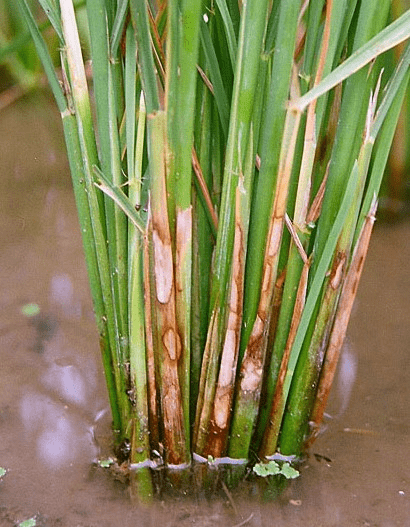Rice crops are susceptible to a variety of diseases caused by fungi, bacteria, viruses, and nematodes. These diseases can significantly reduce yields if not managed effectively. Below is a list of common rice diseases and strategies to manage them:
1. Rice Blast
- Cause: Fungus (Magnaporthe oryzae or Pyricularia oryzae).
- Symptoms:
- Diamond-shaped lesions with gray centers and brown margins on leaves.
- Neck rot on panicles, leading to incomplete grain filling.
- Management:
- Use resistant varieties (e.g., IR64, Swarna).
- Avoid excessive nitrogen application, as it promotes fungal growth.
- Ensure proper field drainage to reduce humidity.
- Apply fungicides like tricyclazole or carbendazim during early outbreaks.
2. Bacterial Leaf Blight (BLB)
- Cause: Bacteria (Xanthomonas oryzae pv. oryzae).
- Symptoms:
- Yellowing and drying of leaf edges, starting from the tips.
- “Kresek” stage: Complete wilting in seedlings.
- Management:
- Use resistant varieties (e.g., Samba Mahsuri).
- Avoid over-flooding and manage water levels to reduce bacterial spread.
- Treat seeds with bactericides like streptomycin sulfate or copper-based compounds.
- Rotate crops with non-host plants like legumes.
3. Sheath Blight
- Cause: Fungus (Rhizoctonia solani).
- Symptoms:
- Oval lesions on leaf sheaths with grayish centers and brown edges.
- Lodging (falling over) of plants due to weakened stems.
- Management:
- Maintain wider spacing between plants to reduce humidity.
- Avoid excessive nitrogen fertilizer.
- Use biological control agents like Trichoderma spp.
- Apply fungicides such as hexaconazole or validamycin.
4. Brown Spot
- Cause: Fungus (Bipolaris oryzae or Helminthosporium oryzae).
- Symptoms:
- Small, round to oval brown spots on leaves, leading to leaf drying.
- Poor grain filling and reduced yield.
- Management:
- Use certified disease-free seeds.
- Treat seeds with fungicides like carbendazim before planting.
- Apply balanced fertilizers, especially potassium and silicon.
- Remove infected plant debris from fields.
5. Tungro Virus
- Cause: Rice tungro bacilliform and spherical viruses transmitted by green leafhoppers.
- Symptoms:
- Yellowing of leaves starting from the tips.
- Stunted plant growth and reduced tillering.
- Management:
- Plant resistant varieties (e.g., Matatag 1, NSIC Rc120).
- Control green leafhopper populations with insecticides like imidacloprid.
- Synchronize planting to minimize pest build-up.
- Remove infected plants to reduce viral spread.
6. Leaf Smut
- Cause: Fungus (Entyloma oryzae).
- Symptoms:
- Small, black smut-like lesions on leaves.
- Reduced photosynthetic capacity leading to lower yields.
- Management:
- Apply fungicides like carbendazim or mancozeb.
- Use resistant varieties.
- Practice crop rotation with non-host crops.
7. Rice Grassy Stunt
- Cause: Rice grassy stunt virus transmitted by brown planthoppers.
- Symptoms:
- Stunted plants with excessive tillering and narrow, pale leaves.
- Panicles often do not develop.
- Management:
- Use resistant varieties like IR62.
- Manage brown planthopper populations with biological controls or selective insecticides.
- Avoid overuse of nitrogen fertilizers that attract planthoppers.
8. False Smut
- Cause: Fungus (Ustilaginoidea virens).
- Symptoms:
- Greenish spore balls replace grains in panicles.
- Reduced grain quality and yield.
- Management:
- Spray fungicides like propiconazole during the panicle initiation stage.
- Use disease-free seeds and clean equipment.
- Rotate crops and remove infected residues after harvest.
9. Stem Rot
- Cause: Fungus (Sclerotium oryzae).
- Symptoms:
- Black lesions at the base of stems, causing lodging.
- Reduced panicle formation and grain filling.
- Management:
- Apply potash fertilizers to strengthen stems.
- Avoid dense planting to reduce humidity.
- Incorporate resistant varieties into the cropping system.
- Use biological controls like Trichoderma spp.
10. Narrow Brown Leaf Spot
- Cause: Fungus (Cercospora janseana).
- Symptoms:
- Narrow, brown streaks on leaves.
- Reduces photosynthetic efficiency and yield.
- Management:
- Apply fungicides like azoxystrobin or carbendazim.
- Improve field drainage and avoid waterlogging.
- Remove plant debris and infected leaves.
11. Root-Knot Nematodes
- Cause: Nematodes (Meloidogyne graminicola).
- Symptoms:
- Galls or knots on roots, stunted growth, and yellowing leaves.
- Poor tillering and reduced grain yield.
- Management:
- Rotate crops with legumes or other non-host plants.
- Use nematicides like carbofuran sparingly.
- Incorporate organic matter to enhance soil health and natural nematode predators.
General Practices for Disease Management in Rice
- Use Resistant Varieties:
- Planting disease-resistant or tolerant varieties is a cost-effective and environmentally friendly approach.
- Adopt Good Agricultural Practices (GAP):
- Proper water management, such as alternate wetting and drying (AWD), can reduce diseases like sheath blight and stem rot.
- Timely planting and harvesting minimize exposure to pests and diseases.
- Seed Treatment:
- Treat seeds with fungicides or biological agents to eliminate seed-borne pathogens.
- Field Sanitation:
- Remove and destroy infected plant residues to reduce the source of inoculum for the next cropping season.
- Balanced Fertilization:
- Avoid excessive nitrogen fertilizer, which promotes susceptibility to diseases.
- Apply adequate potassium and silicon to strengthen plant defenses.
- Integrated Pest and Disease Management (IPDM):
- Combine cultural, biological, and chemical methods to manage both pests and diseases effectively.
- Monitoring and Early Detection:
- Regular field scouting helps identify disease symptoms early, allowing timely intervention.
- Crop Rotation:
- Alternating rice with non-host crops breaks the lifecycle of pathogens.
- Application of Biological Controls:
- Use beneficial microbes like Trichoderma spp. or biofertilizers to suppress diseases and promote plant health.
- Climate-Smart Farming:
- Monitor weather patterns to predict disease outbreaks and take preventive measures accordingly.
Conclusion
Effective management of rice diseases involves a combination of resistant varieties, good farming practices, early detection, and integrated pest and disease management strategies. By implementing these measures, farmers can reduce yield losses, minimize chemical use, and ensure sustainable rice production.
Hashtags
#RiceFarmers #AgriculturalTechnology #CropHealth #OrganicFarming #PrecisionFarming #RiceProduction #FarmingCommunity #PestControl #CropScience #RiceVarieties #FarmingInnovation #SustainableDevelopment #RiceHarvest #FarmingTips #ClimateSmartAgriculture #RiceFields #FarmingSolutions #CropManagement #RiceYield #FarmingSuccess









